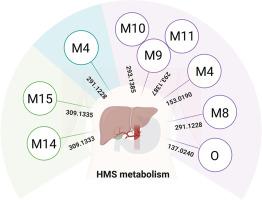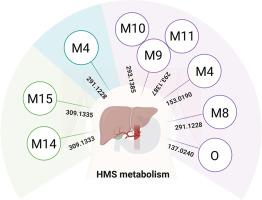Innovative analytical techniques for identifying metabolites of the UV filter homosalate through UPLC–MS: Environmental and health implications
IF 7.3
2区 环境科学与生态学
Q1 ENVIRONMENTAL SCIENCES
引用次数: 0
Abstract
Homosalate (HMS), a widely used sunscreen ingredient, functions as a UVB absorber, protecting against harmful ultraviolet radiation. Nevertheless, laboratory investigations have prompted concerns regarding its potential to disrupt endocrine function, given that HMS demonstrates both estrogenic and anti-androgenic properties. These effects could be shaped by its metabolic byproducts. Certain HMS metabolites may carry toxicological implications. To date, no research has applied an untargeted metabolomics methodology to comprehensively explore HMS metabolism using high-resolution mass spectrometry. In this study, we used three advanced metabolomics-based data-processing approaches to comprehensively identify HMS metabolites from human liver enzyme incubation samples including two-dose difference coupled with stable isotope tracing, dose-response relationship coupled with stable isotope tracing, and mass defect filter coupled with stable isotope tracing. We identified nine peaks with the proposed structures as potential HMS metabolites. Previously reported HMS metabolites, including salicylic acid, HMS-carboxylic acid, aryl-alkyl-dihydroxylated HMS, and aryl-hydroxylated HMS-carboxylic acid, were confirmed in this study. We confirmed the proposed salicylic acid by comparison with an authentic standard. Salicylic acid may be the major HMS metabolite, showing significantly higher abundance compared with the other identified metabolites. However, salicylic acid originates from various sources, making it difficult to determine its origin. In addition, we identified two novel metabolites: M4 and M14/M15. M4 was proposed to be a hydroxylated salicylic acid; therefore, it was not an HMS structure-specific metabolite and could not serve as an exposure biomarker. In contrast, M14 and M15—identified as isomers—were proposed to be aryl-monohydroxylated-alkyl-dihydroxylated HMS and are considered HMS structure-specific metabolites. The potential of these two isomers as exposure biomarkers should be further validated in future studies.


通过UPLC-MS鉴定紫外滤光剂的代谢物的创新分析技术:环境和健康影响
高盐酸盐(HMS)是一种广泛使用的防晒成分,其功能是吸收UVB,防止有害的紫外线辐射。然而,鉴于HMS具有雌激素和抗雄激素的特性,实验室研究已经引起了人们对其可能破坏内分泌功能的担忧。这些影响可能是由它的代谢副产物形成的。某些HMS代谢物可能具有毒理学意义。迄今为止,还没有研究应用非靶向代谢组学方法利用高分辨率质谱全面探索HMS代谢。本研究采用了基于代谢组学的三种先进的数据处理方法,包括双剂量差耦合稳定同位素示踪、剂量-反应关系耦合稳定同位素示踪和质量缺陷滤波耦合稳定同位素示踪,对人肝酶培养样品中的HMS代谢物进行了综合鉴定。我们确定了9个峰,这些峰的结构可能是HMS代谢产物。先前报道的HMS代谢物,包括水杨酸、HMS-羧酸、芳基-烷基-二羟基化HMS和芳基-羟基化HMS-羧酸,在本研究中得到证实。我们通过与一个真正的标准进行比较,证实了所建议的水杨酸。水杨酸可能是HMS的主要代谢物,与其他已鉴定的代谢物相比,水杨酸的丰度明显更高。然而,水杨酸的来源多种多样,因此很难确定其来源。此外,我们还鉴定了两种新的代谢物:M4和M14/M15。M4被认为是羟基化水杨酸;因此,它不是HMS结构特异性代谢物,不能作为暴露生物标志物。相比之下,被鉴定为异构体的M14和m15被认为是芳基单羟基化-烷基二羟基化的HMS,被认为是HMS结构特异性代谢物。这两种异构体作为暴露生物标志物的潜力应在未来的研究中进一步验证。
本文章由计算机程序翻译,如有差异,请以英文原文为准。
求助全文
约1分钟内获得全文
求助全文
来源期刊

Environmental Pollution
环境科学-环境科学
CiteScore
16.00
自引率
6.70%
发文量
2082
审稿时长
2.9 months
期刊介绍:
Environmental Pollution is an international peer-reviewed journal that publishes high-quality research papers and review articles covering all aspects of environmental pollution and its impacts on ecosystems and human health.
Subject areas include, but are not limited to:
• Sources and occurrences of pollutants that are clearly defined and measured in environmental compartments, food and food-related items, and human bodies;
• Interlinks between contaminant exposure and biological, ecological, and human health effects, including those of climate change;
• Contaminants of emerging concerns (including but not limited to antibiotic resistant microorganisms or genes, microplastics/nanoplastics, electronic wastes, light, and noise) and/or their biological, ecological, or human health effects;
• Laboratory and field studies on the remediation/mitigation of environmental pollution via new techniques and with clear links to biological, ecological, or human health effects;
• Modeling of pollution processes, patterns, or trends that is of clear environmental and/or human health interest;
• New techniques that measure and examine environmental occurrences, transport, behavior, and effects of pollutants within the environment or the laboratory, provided that they can be clearly used to address problems within regional or global environmental compartments.
 求助内容:
求助内容: 应助结果提醒方式:
应助结果提醒方式:


